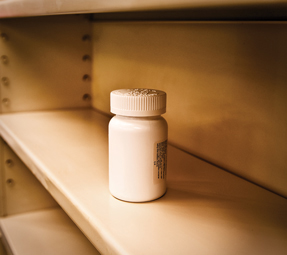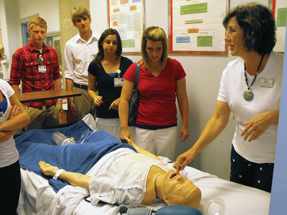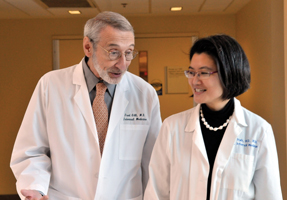Drugs come up short for doctors, patients
Drug shortages, especially among injectables and cancer medications, have left physicians and patients alike wondering where their next doses will come from. Even simple antibiotics have become scarce commodities.
Tina Dobsevage, MD, ACP Member, hit the brick wall of drug shortages in January, when she prescribed tetracycline for an elderly woman who was suffering from a urinary tract infection.
After reviewing the patient's lab results and consulting with an infectious disease specialist, Dr. Dobsevage determined that tetracycline was likely the only oral antibiotic that might combat the resistant bacteria involved. But the New York City solo practitioner was floored to discover that the long-standing drug had become a scarce commodity.

Her office contacted three pharmacies to cobble together the 20 pills needed to treat her patient for 10 days.
“Pharmacies were giving me the last of their tetracycline,” Dr. Dobsevage said. “I was shocked because it's been always available, it's so useful. I've treated people with this for 20 years. And then it vanishes.”
Tetracycline, which was listed as unavailable as of March, joins an expanding list of drug shortages nationally. The problem and related treatment frustrations first emerged a decade ago but have ratcheted up in recent years, according to clinicians and statistics from the University of Utah's Drug Information Service, which provides data for the American Society of Health-System Pharmacists (ASHP). In 2011, 267 new shortages were reported compared with 70 in 2007.
The bulk of shortages—between one-half to nearly two-thirds depending on the year—have involved injectable medications, including those used to treat people with cancer and hospitalized patients, according to the Drug Information Service.
But a significant number of drug access problems also have frustrated primary care doctors and their patients. Some examples of recent or ongoing shortages include ciprofloxacin, metformin, metoprolol, trazodone and some of the attention-deficit disorder medications, according to officials at the Drug Information Service and ASHP who were interviewed this spring.
Patients and doctors alike are left to cope with the fallout. Patients may have to shuttle between pharmacies to track down their preferred drug or may have to shoulder larger insurance co-pays if a shortage forces them to switch to an alternative.
Physicians like Dr. Dobsevage might have to devote more time to coordinating with pharmacies and insurance providers to locate a drug, or a cost-effective option. And, depending on the drug switch involved, the doctor might have to more closely monitor the patient to verify that the substitute drug works just as well without any new side effects.
Given that it's so difficult to convince patients to stick with their medications in the first place, any changes can potentially derail adherence, said Erin Fox, PharmD, who directs the Drug Information Service. After all, the primary care doctor essentially has to make a pitch that a particular drug is the best choice for that patient, she said.
“What if the patient then goes to the pharmacy and finds out they can't fill that medicine?” Dr. Fox asked. “How does the doctor convince them that the other [substitute] medicine is going to work just as well?”
Earlier intervention
In recent months, looming shortages of chemotherapy drugs have garnered considerable attention, given the high treatment stakes and limited alternatives available. But data collected by the Drug Information Service show that chemotherapy agents represented only 26 of the 267 shortages identified last year. Other frequently affected drug categories included antibiotics and cardiovascular and central nervous system drugs.
In a report issued last fall, officials at the U.S. Food and Drug Administration (FDA) attributed 43% of the shortages in 2010 and 2011 to problems at manufacturing facilities. Other reported causes included manufacturing or shipping delays (15%) and shortages in the active pharmaceutical ingredients required to make the drugs (10%).
To boost pressure on the manufacturers, FDA officials issued a letter, also last fall, reminding them of their obligation to voluntarily notify the federal agency of a developing supply problem, even if such reporting is not legally required.
That letter, released in conjunction with an executive order from President Obama, resulted in a sixfold increase in voluntary notifications, according to data provided by FDA officials in late February. An earlier heads up can give federal officials more time to intervene, they said in a press release. In 2011, a total of 195 drug shortages were prevented. Following last fall's executive order, 114 shortages were.
As one example, FDA officials in February pointed to the recent supply difficulties with two cancer drugs, doxorubicin (Doxil) and methotrexate.
For doxorubicin, which was in critical shortage, FDA officials approved the temporary importation of an alternative drug, Lipodox (doxorubicin hydrochloride liposome injection). For methotrexate, they worked with several manufacturers to boost production and thus replenish rapidly declining supplies, FDA officials reported. The federal agency also expedited approval of a preservative-free generic version of methotrexate manufactured by APP Pharmaceuticals.
Several legislative bills also have been proposed, including a bipartisan pair, S. 296 and H.R. 2245. Dubbed the Preserving Access to Life-Saving Medications Act, the bills would require manufacturers to alert federal officials at least six months prior to an anticipated disruption or discontinuance of a particular drug.
Fortunately, the shortages to date haven't created as many thorny treatment challenges for general internists as they have for other specialists, such as oncologists, said Gerald Smetana, MD, FACP, a staff physician at Beth Israel Deaconess Medical Center in Boston and an associate professor of medicine at Harvard Medical School.
“So far it's been in more of a nuisance category than troubling,” he said. “I haven't yet seen a situation where there has been a life-sustaining drug for which there's no alternative in primary care practice.”
Still, he said, there's a “hassle factor” for both the patient and the doctor as they determine the best alternative.
And sometimes patient frustrations can boil over, understandably so, Dr. Fox said, citing supply fluctuations with the attention-deficit disorder drug Adderall (dextroamphetamine and amphetamine) as one illustration.
“Many patients taking Adderall have already been on the alternative agents and they were not helpful or successful for them,” she said. “Instead we have patients calling around to 10 to 15 different pharmacies trying to see who might have stock of their needed strength.”
Preventing risk
Swapping out even equivalent drugs is risky when the long-term goal is to convince patients to stick with a drug regimen, said Yul D. Ejnes, MD, MACP, who practices in a general internal medicine group near Providence, R.I.
“Patients are certainly rattled by the disruption in their treatment,” he said. “Some take it better than others. Getting patients to take a medication in the first place is often a challenge.”
Additional monitoring also might be needed when patients are switched to a different formulation or another agent in the same drug class, as there can be differences in effectiveness or potential side effects, said Cynthia Reilly, RPh, who directs the practice development division at ASHP and is part of a team working on drug shortage issues.
“Particularly with antidepressants and antipsychotics, why one drug works for one patient versus another, there's a lot of art in that in addition to science,” she said. “So if you switch to another therapy, you may find that the patient isn't responding as well.”
Metoprolol was another example frequently cited by clinicians as they described how substitutions aren't always clear cut. Although the tablets were available early this year, previously there have been periodic disruptions in various dosages of the beta-blocker, according to Dr. Fox.
When the once-a-day extended version (metoprolol succinate) was temporarily unavailable, a doctor couldn't simply substitute the twice-a-day version, sold under the name metoprolol tartrate, Dr. Ejnes said. Both drugs contain the same active ingredient, but compounding differences mean that taking two 50-mg tablets daily won't necessarily provide the same drug effect as one 100-mg tablet of the extended release, he said. The doctor may have had to bring in the patient sooner to check that the drug was working as well, he said.
Proactive steps
To guard against surprises at the pharmacy counter, it's important that doctors monitor what drugs are in short supply, Dr. Fox said. Along with ASHP, the FDA also provides drug shortage details online (See sidebar, “Tracking shortages”).
Due to the extensive media coverage, patients will likely already be aware of shortage problems, Ms. Reilly said. Still, “Physicians need to explain why they're making the substitution and explain to them [patients] how it will work,” she said. “In general, we should be selecting therapies that are as effective, so driving that point home with the patient is important.”
Depending on the alternative drug used, and the patient's insurance coverage, a larger co-pay may be required. Insurance providers sometimes have waived the higher fee due to shortages, but not consistently, Ms. Reilly said. “We could be pushing patients to brand names or different therapies that are more expensive in terms of their co-pay.”
Also, because some drug substitutions might crop up unexpectedly, it's more important than ever for the primary care doctor to keep a current list of all the drugs the patient is taking, prescribed through that doctor's office and other specialists, Ms. Reilly said.
Dr. Smetana, who works at the hospital-based internal medicine practice at Beth Israel Deaconess, acknowledged that his physician group has the luxury of support from a clinical pharmacist. The pharmacist will alert the physicians via e-mail of a looming supply problem and will assist patients when they can't fill a particular prescription.
But, he said, “It has taken an increasing amount of her time to research and address these issues for us.”
Looking forward
Despite the recent stresses on patient care, Dr. Fox pointed to some hopeful signs. Amid the intensive public scrutiny, more drug manufacturers are working with FDA officials before a shortage reaches a crisis level, she said. During the first two months of 2012, a total of 30 new shortages were reported, half the number that had been reported during the same stretch in 2011, she said.
But each shortage can extend for months, or even longer. As of early March, the Drug Information Service was monitoring some 300 shortages around the country, according to Dr. Fox. And the primary underlying cause persists, she said.
“The main reason that these shortages are happening is because of quality issues at the manufacturing sites,” she said. “So for whatever reason, and we don't know why, these manufacturing facilities are broken. They are having problems.”
The scenario with tetracycline, also frequently prescribed for acne prevention, might signal drug roadblocks to come, Dr. Fox said. One manufacturer reported that the raw material was not available to make the drug and the other hadn't provided an explanation, according to details on the ASHP website.
“If you get a prescription for tetracycline, there is no way to fill that,” Dr. Fox said in March. “That's one I just don't know if we're going to see return to supply, or if this is going to be another antibiotic that is permanently discontinued.”





